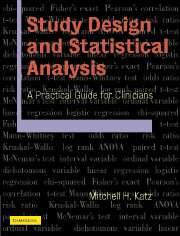Book contents
- Frontmatter
- Contents
- Preface
- 1 Introduction
- 2 Designing a study
- 3 Data management
- 4 Univariate statistics
- 5 Bivariate statistics
- 6 Multivariable statistics
- 7 Sample size calculations
- 8 Studies of diagnostic and prognostic tests (predictive studies)
- 9 Statistics and causality
- 10 Special topics
- 11 Publishing research
- 12 Conclusion
- Index
10 - Special topics
Published online by Cambridge University Press: 05 August 2012
- Frontmatter
- Contents
- Preface
- 1 Introduction
- 2 Designing a study
- 3 Data management
- 4 Univariate statistics
- 5 Bivariate statistics
- 6 Multivariable statistics
- 7 Sample size calculations
- 8 Studies of diagnostic and prognostic tests (predictive studies)
- 9 Statistics and causality
- 10 Special topics
- 11 Publishing research
- 12 Conclusion
- Index
Summary
What is the difference between the relative risk and the absolute risk?
Relative risks (risk ratios and rate ratios (RR)) identify the risk factors for particular outcomes. However, they cannot tell you how likely an outcome is to occur, only how much more likely the outcome is to occur in one group than the other. Therefore, knowing the relative risk is not very helpful in clinical situations. In contrast, an absolute risk tells you how likely an outcome is to occur.
The difference between the relative risk and absolute risk is particularly great with rare diseases because a person at high relative risk of developing a disease (compared to an unexposed person) may still be very unlikely to develop that disease. For example, the relative risk of developing esophageal cancer is 40–125 higher among persons with Barrett esophagus. For persons newly diagnosed with Barrett esophagus this must sound like a certainty that they will develop cancer. In fact, the absolute risk of developing cancer if you have Barrett esophagus has been estimated at 0.5% per year (one in two hundred). Despite the high relative risk, the absolute risk is low because esophageal cancer is a rare disease.
What other effect measures are available in addition to relative risk and absolute risk?
In addition to relative risk and absolute risk, several related effect measures are available. Each one characterizes the association between a risk factor and an outcome differently. The different measures, along with their meaning, and their uses, are shown in Table 10.1.
- Type
- Chapter
- Information
- Study Design and Statistical AnalysisA Practical Guide for Clinicians, pp. 165 - 171Publisher: Cambridge University PressPrint publication year: 2006



